

Brainpickings. This Explains Everything: 192 Thinkers Each Select the Most Elegant Explanation of How the World Works. The Data Visualisation Catalogue. Data visualization chart. Visual analytics 101: when to use numbers vs. visualizations. Bar charts just so happen to be one of the best visualizations for comparing data.
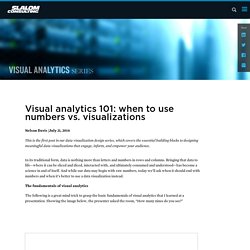
Knowing the order of east region sales by Product Type, highest to lowest (Coffee, Espresso, Herbal Tea, and Tea), is much more important than knowing the actual numbers for any one metric (e.g., sales in the west region for herbal tea are $72,285). Heutagogy and lifelong learning: A review of heutagogical practice and self-determined learning. Lisa Marie Blaschke Oldenburg University and University of Maryland University College (UMUC) Abstract Heutagogy, a form of self-determined learning with practices and principles rooted in andragogy, has recently resurfaced as a learning approach after a decade of limited attention.

In a heutagogical approach to teaching and learning, learners are highly autonomous and self-determined and emphasis is placed on development of learner capacity and capability with the goal of producing learners who are well-prepared for the complexities of today’s workplace. The approach has been proposed as a theory for applying to emerging technologies in distance education and for guiding distance education practice and the ways in which distance educators develop and deliver instruction using newer technologies such as social media. TRANS Nr. 15: Josephine Papst (Graz): Transdisciplinarity: The Unifying Paradigm of Humanities, Natural and Social Sciences. Josephine Papst (indexicals - Centre of transdisciplinary cognitive and state-system sciences, Graz, Austria) [BIO] Abstract The central characteristics of classical philosophy are the commitment to universality, the request to understand and to explain reality with its visible and invisible features, the request to understand what there is beyond the everyday visible world; in short: to get truth, the good and beauty.
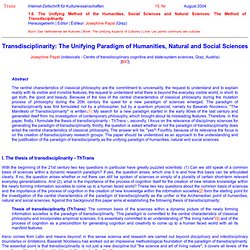
Taxonomy. Inquiry-based Learning: Explanation. What is inquiry-based learning?

An old adage states: "Tell me and I forget, show me and I remember, involve me and I understand. " The last part of this statement is the essence of inquiry-based learning, says our workshop author Joe Exline 1. Inquiry implies involvement that leads to understanding. Inquiry. What is Inquiry?
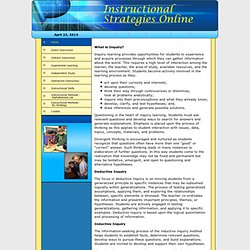
Inquiry learning provides opportunities for students to experience and acquire processes through which they can gather information about the world. This requires a high level of interaction among the learner, the teacher, the area of study, available resources, and the learning environment. Students become actively involved in the learning process as they: Blooms Taxonomy Action Verbs. CBS_InquiryBased. Critical Thinking Pathways. Critical thinking is trendy these days.

With 6.3 million hits resulting from a Google search -- six times "Bloom's Taxonomy" -- its importance is undeniable. Worldwide, critical thinking (CT) is integrated into finger-painting lessons, units on Swiss immigrants, discussions of Cinderella, and the Common Core State Standards. In short, critical thinking is more beloved than Egyptian cotton. Definitions abound. The Theory Underlying Concept Maps and How to Construct and Use Them.
Bloomin' Apps. This page gathers all of the Bloomin' Apps projects in one place.Each image has clickable hotspots and includes suggestions for iPad, Android, Google and online tools and applications to support each of the levels of Bloom's Revised Taxonomy.I have created a page to allow you to share your favorite online tool, iOS, or Android app with others.
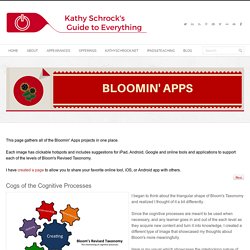
Cogs of the Cognitive Processes. Blended Learning. Workshop: ICT for a change - How teaching in the unified classroom ... BLIG-2.0-Final-Paper. Hybrid Pedagogy: A Digital Journal of Learning, Teaching, and Technology. The Basics of Blended Learning. Bloom's 'Digital' Taxonomy - Printable Reference Table. Sketchnotes and Visual Thinking. Tagxedo - Word Cloud with Styles. Flip This: Bloom’s Taxonomy Should Start with Creating.
Teaching Strategies Chris Davis, Powerful Learning Practice LLC By Shelley Wright I think the revised Bloom’s Taxonomy is wrong.

I know this statement sounds heretical in the realms of education, but I think this is something we should rethink, especially since it is so widely taught to pre-service teachers. I agree that the taxonomy accurately classifies various types of cognitive thinking skills. Conceived in 1956 by a group of educators chaired by Benjamin Bloom, the taxonomy classifies skills from least to most complex. Many teachers in many classrooms spend the majority of their time in the basement of the taxonomy, never really addressing or developing the higher order thinking skills that kids need to develop.
Rather than starting with knowledge, we start with creating, and eventually discern the knowledge that we need from it. Assessment and Rubrics. Education vs Learning - What Exactly is the Difference? The 6 Levels Of Bloom's Taxonomy, Explained With Active Verbs. Learning, powered by imagination. - Memrise. Academic. Create Infographics online. How to make an infographic online: five essential free tools.
Given the popularity of infographics, you’d be wise to consider using them to help achieve your content marketing goals.

They can be great for social sharing, blog fodder and inbound links. The last time I created an infographic I used – wait for it - Microsoft Excel. Thankfully there are now some far better options, and they're surprisingly easy to use. I have compiled five of online tools that will help you to create infographics. They’re all free, though some require registration (or to connect your Twitter or Facebook account) and most have the upgrade options. Hold on a moment! Before you begin, consider that many infographics are often – to quote Econsultancy Research Director Linus Gregoriadis – “high on graphics and low on information”.
As such it is important to map out your story / message / goals before starting to work on the design itself. There’s a great post on the LEWIS PR blog that explains how to optimise an infographic, based around three key questions, which are: 1. 2. 3. Create HTML5 Interactive Online Presentations, Animations, infographics & banners - Presenter by Easy WebContent. Visuality. Apps for Bloom's Taxonomy. Technology. Bloom's Taxon. & Objectvs. Bloom's taxonomy. Adult learning. Learning Theories. Becomes Google Apps Premier Technology Partner! Mind Mapping Software, Brainstorming, GTD and Knowledgebase Software. KM Tools. Apps for Bloom's Taxonomy. Didactics.
The Pseudoscience of Jane Jacobs and Innovation Districts. Where we find innovation, we find industry clusters.
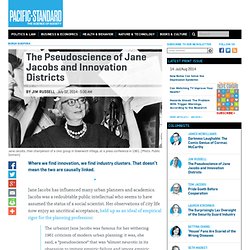
That doesn’t mean the two are causally linked. Jane Jacobs has influenced many urban planners and academics. Jacobs was a redoubtable public intellectual who seems to have assumed the status of a social scientist. Connect The Dots. 3 Myths of Flipped Learning. We live in the 21st Century. We have students learning subjects through online lessons, quite frankly, all the time.
We live in a society that boasts pervasive mobile technology and low cost, user friendly Web Tools. We have access to credible and compelling educational research data describing the significant impact that Flipped-Learning has on student achievement. Despite all of the above, the term Flipped-Learning seems to ignite fiery debate, sometimes it’s even strongly opposed. When analysing the opposition to Flipped-Learning, we find there are three dominant misconceptions. It’s important that we understand the reasons why these myths are incorrect. Whats-lost-as-handwriting-fades.